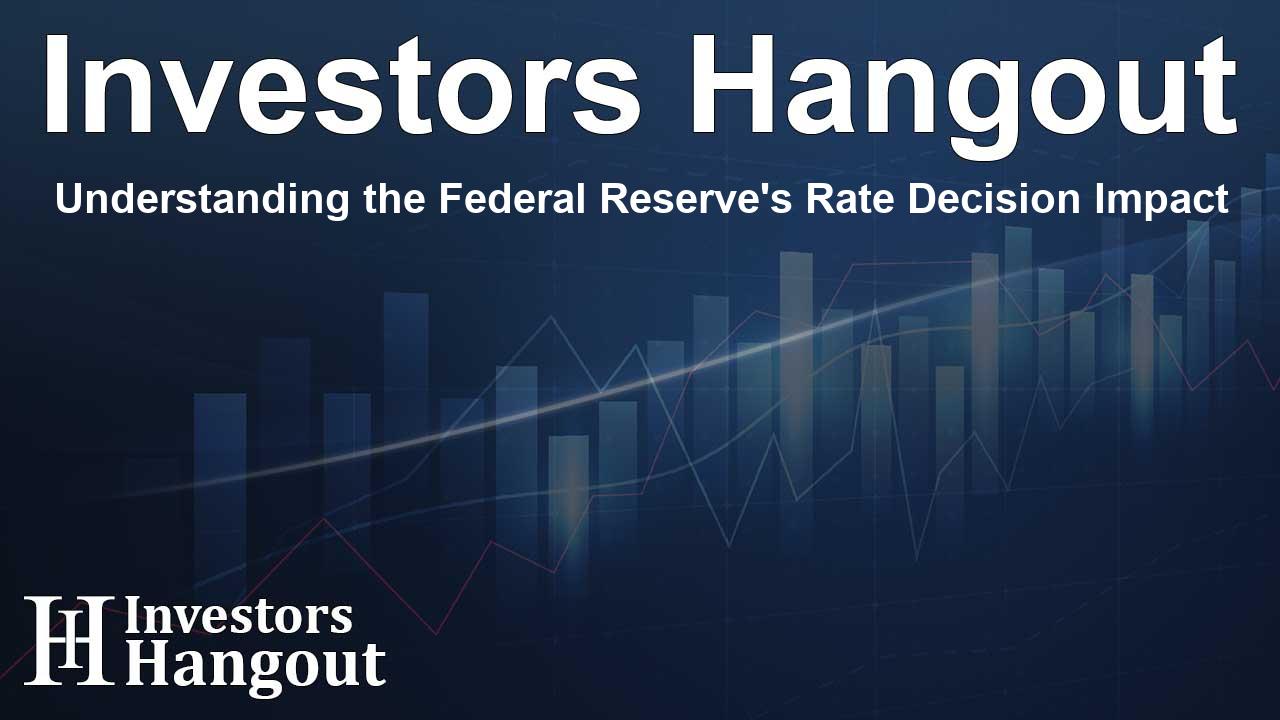Understanding the Federal Reserve's Rate Decision Impact

Understanding the Federal Reserve's Upcoming Rate Decision
The Federal Reserve is preparing to announce its decision regarding interest rates, a pivotal moment that comes amidst a backdrop of fluctuating inflation rates and lingering economic uncertainties. With inflation gradually decreasing, attention is centered on the Fed's approach to maintaining stability and growth. Investors are keenly anticipating insights from Fed Chair Jerome Powell, whose statements could significantly influence market outlook and monetary policy moving forward.
Anticipated Consensus: Holding Rates Steady
The prevailing sentiment in financial markets suggests a high probability, between 96-97%, that the Federal Reserve will opt to maintain its current federal funds rate within the range of 5.25% to 5.50%. This expectation is an indication of the confidence investors have in the Fed's cautious approach during this crucial meeting.
Rationale for a Steady Rate
Several factors contribute to the rationale behind holding interest rates steady. Firstly, core inflation remains stubbornly above the Fed's desired target of 2%. Recent figures indicate that the Core Consumer Price Index (Core CPI) was recorded at 2.7% year-over-year, which, although lower than previous peaks, is still a concern for policymakers striving for price stability.
Additionally, global trade tensions, particularly those between major economies, continue to introduce inflationary risks that could disrupt price stabilization efforts. Tariff escalations or supply chain disturbances may elevate commodity prices, complicating the economic landscape.
Moreover, the resilience of the U.S. economy cannot be overlooked. With an unemployment rate at approximately 4.0% and robust job creation statistics, coupled with a GDP growth rate exceeding expectations at 2.3% year-on-year, the Fed feels empowered to adopt a cautiously optimistic stance rather than hastily reducing rates.
Lastly, despite external calls for a change in policy due to declining inflation—voices echoed by several political figures—the Fed remains wary of the repercussions associated with prematurely cutting rates. Historical precedence from the 1970s is a reminder of the dangers linked to early interventions, which led to a resurgence of inflation and necessitated stringent policy reversals. Hence, an inclination towards maintaining a vigilant approach is likely.
Insights Expected from Powell’s Upcoming Speech
Given the anticipated decision to hold rates steady, Jerome Powell’s subsequent press conference is poised to be a defining moment for market reactions. He is expected to strike a careful balance between upholding the Federal Reserve's commitment to inflation control while addressing market concerns regarding excessive tightenings in policy. His key messages are likely to encapsulate several important themes:
- Acknowledging Progress While Exercising Caution: Powell will recognize progress made concerning inflation metrics yet emphasize that the rates remain above target, thus necessitating vigilance in policy.
- Reaffirming a Data-Driven Approach: The Fed will likely maintain that future decisions will hinge purely on incoming economic data from inflation and labor markets, as opposed to predetermined timelines.
- Caution Against Premature Easing: Powell will likely warn against the risks associated with early rate cuts, emphasizing the need for sustained caution to avoid reigniting inflation.
- Confidence in Economic Strength: The Chair is expected to assert the strength of the U.S. economy and labour market while reassuring that the nation is not experiencing a recession.
- Highlighting External Economic Risks: Powell may address international factors such as rising global bond yields and trade disputes, noting their potential impacts on the U.S. economy.
- Stressing the Importance of Independence: In light of political pressures, especially those directed at him, Powell will likely reiterate the significance of the Fed's independence, reminding that decisions are based on data rather than political influences.
This assertion of the Fed's autonomy is crucial, especially now, when external pressures could undermine its credibility. Powell's defense may serve as a reminder of the importance of steadfastness in monetary policy amidst fluctuating political motivations.
Michel Saliby
Senior Market Analyst at FxPro
Frequently Asked Questions
What is the current interest rate set by the Federal Reserve?
The Federal Reserve is currently expected to hold the rate steady in the range of 5.25% to 5.50%.
Why do markets expect the Federal Reserve to keep rates unchanged?
Markets believe the Fed will maintain rates due to ongoing inflation concerns and a resilient labor market.
What factors might influence the Federal Reserve's decision?
Core inflation levels, global trade tensions, and economic growth rate metrics are key factors influencing the decision.
What should investors look for in Powell's speech?
Investors should pay attention to Powell's comments on inflation, economic strength, and the Fed's response to ongoing political pressures.
How does central bank independence affect monetary policy?
Central bank independence ensures that monetary policy decisions are made based on economic data, not influenced by political pressure, thus preserving credibility and stability.
About The Author
Contact Ryan Hughes privately here. Or send an email with ATTN: Ryan Hughes as the subject to contact@investorshangout.com.
About Investors Hangout
Investors Hangout is a leading online stock forum for financial discussion and learning, offering a wide range of free tools and resources. It draws in traders of all levels, who exchange market knowledge, investigate trading tactics, and keep an eye on industry developments in real time. Featuring financial articles, stock message boards, quotes, charts, company profiles, and live news updates. Through cooperative learning and a wealth of informational resources, it helps users from novices creating their first portfolios to experts honing their techniques. Join Investors Hangout today: https://investorshangout.com/
The content of this article is based on factual, publicly available information and does not represent legal, financial, or investment advice. Investors Hangout does not offer financial advice, and the author is not a licensed financial advisor. Consult a qualified advisor before making any financial or investment decisions based on this article. This article should not be considered advice to purchase, sell, or hold any securities or other investments. If any of the material provided here is inaccurate, please contact us for corrections.
